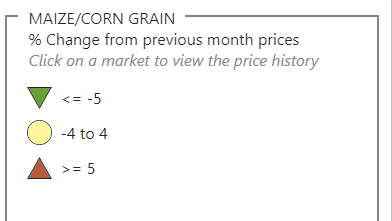The Commodity Price Change visualization is a map with markets and specified product price change over the selected period in each. This visualization is normally used in markets and trade reports and Food Security Outlook reports as required.
Use the following guidelines to create a Commodity Price Change visualization.
* = typically required for reports
Standard visualization fields
Internal Title: This field is optional and will not show up in the report. You may use it to help you quickly identify a specific visualization in your report in the CMS.
*Alt Text: Provide a brief description of what the visualization shows. Learn more about writing alt text for FEWS NET visualizations.
*Show Figure Label: If the visualization is referred to in the text of the report and needs a figure number (i.e. Figure 1), make sure this toggle is turned on. Turn this toggle off for visualizations being used in country and region pages.
*Pick a visualization type: Choose Commodity Price Change Map.
Visualization specific fields
*Data selection fields
Choose a dataset, one or more data series, or a combination of product and country or geographic group. Do not select both country and geographic group. You can also select country, geographic group and/or product in combination with a dataset.
There is an option to choose two sets of data to be shown at different zoom levels. This option only works if you choose both a dataset and a zoom dataset. This is most useful for regional maps.
Dataset: You can use the search box to search datasets by user name and title. This dataset will be used at the default zoom level (zoomed out) and in static images.
Zoom dataset: You can use the search box to search datasets by user name and title. This dataset will be used at the higher zoom levels (zoomed in).
Data series: You can select multiple data series by holding down the CTRL button.
Select a country: Select a country if you are creating a country report and you are not using a dataset/dataseries or if the dataset/dataseries that you have selected contain data for more than one country.
Select a geographic group: Select a geographic group if you are creating a regional report and you are not using a dataset/dataseries or if the dataset/dataseries that you have selected contain data for more than one region.
Product: Select a product if a product is not indicated in your dataset/data series selection or if you are not using a dataset/dataseries.
Mapping parameters
*Period Date: A period date is needed to ensure that new data after the report date isn’t included automatically. This date should be entered as the last day of the report month.
If the visualization is being used on a country or a region page, rather than in a report, then the period date should be left blank so that the visualization updates automatically as new data is published.
Historic range for percent change: If not selected, this will default to the first item in the list for which there is data. Selecting ‘Actual Price’ will display the actual prices on the selected period date.
Price type: If not selected, the most frequent price type will be applied. This only applies if no dataset/data series is selected.
Product source: If not selected, the most frequent product source will be applied. This only applies if no dataset/data series is selected.
Unit of measure: If not selected, the most frequent unit of measure will be applied. This only applies if no dataset/data series is selected.
Number of buckets: The number of buckets defaults to a standard for the country. This, along with the thresholds, can be edited if they are not appropriate for the current data.
List of thresholds: By default this is left blank. However, you can change the thresholds for each bucket by entering comma separated values. You should use the upper values of all buckets except the top bucket. See the example below. Submit a help desk ticket if you need support with changing thresholds.

Common currency: If not selected, this will default to USD. You can choose an option here to change the common currency to be calculated against.
Auto-generated fields
All of these fields will be automatically generated but can be overridden if desired.
Visualization title: The auto-generated title will be formatted as follows:
|
|
Formula |
Example |
|---|---|---|
|
Title |
Percent Change of {Period month and year} {Product} prices to the {Historic range} in Selected Markets in {Country/Region name} |
Percent Change of September 2022 Maize/corn Prices to the Previous Month in Selected Markets in Zambia |
Disclaimer: By default, there is no disclaimer for these maps unless this map is for Ethiopia. In that case, it will contain the standard disclaimer about Ethiopia administrative boundaries.
Source Attribution: The auto-generated source attribution is a compilation of the data source organization names stored in FDW for the data used to create the map.
Generate the visualization
*Generate URL: Click this button once you have filled out the fields above to generate the visualization. The system will provide a thumbnail of the visualization and a URL where you can preview the visualization. Note: It may take a minute to generate the thumbnail image. Make sure you allow the thumbnail to load before saving the visualization.
The system will automatically populate the remaining fields: Data Visualization Type, Primary URL, Image URL, and JSON Configuration. These SHOULD NOT be edited.
PDF formatting options
Show full width in PDF: By default, this toggle should be turned off. You may want to show a visualization in full width if you have a very detailed chart that needs to be larger than 50% of the page width.
Float Position: Sets the orientation data visualizations that are not full width. Defaults to Right. For side-by-side images, set the first image to Left. For full width images, set to None.
